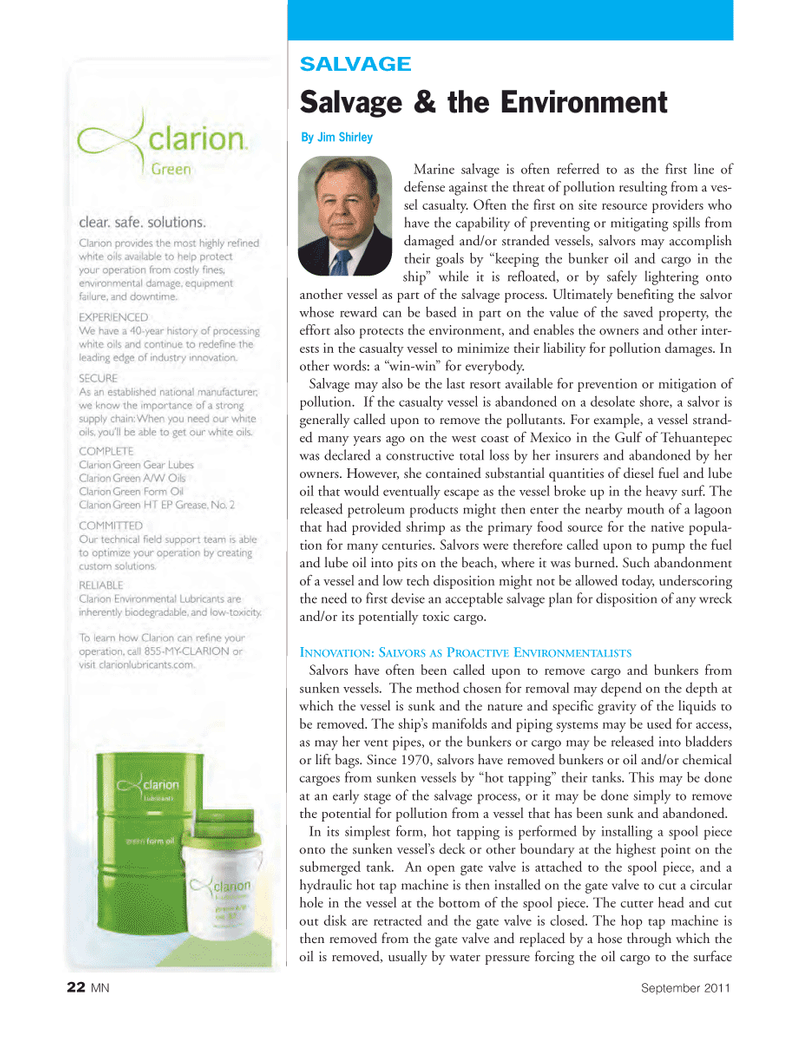
Page 22: of Marine News Magazine (September 2011)
The Environmental Edition
Read this page in Pdf, Flash or Html5 edition of September 2011 Marine News Magazine
SALVAGE Marine salvage is often referred to as the first line of defense against the threat of pollution resulting from a ves- sel casualty. Often the first on site resource providers who have the capability of preventing or mitigating spills from damaged and/or stranded vessels, salvors may accomplish their goals by ?keeping the bunker oil and cargo in the ship? while it is refloated, or by safely lightering onto another vessel as part of the salvage process. Ultimately benefiting the salvor whose reward can be based in part on the value of the saved property, the effort also protects the environment, and enables the owners and other inter- ests in the casualty vessel to minimize their liability for pollution damages. In other words: a ?win-win? for everybody. Salvage may also be the last resort available for prevention or mitigation of pollution. If the casualty vessel is abandoned on a desolate shore, a salvor is generally called upon to remove the pollutants. For example, a vessel strand- ed many years ago on the west coast of Mexico in the Gulf of Tehuantepec was declared a constructive total loss by her insurers and abandoned by her owners. However, she contained substantial quantities of diesel fuel and lube oil that would eventually escape as the vessel broke up in the heavy surf. The released petroleum products might then enter the nearby mouth of a lagoon that had provided shrimp as the primary food source for the native popula- tion for many centuries. Salvors were therefore called upon to pump the fuel and lube oil into pits on the beach, where it was burned. Such abandonment of a vessel and low tech disposition might not be allowed today, underscoring the need to first devise an acceptable salvage plan for disposition of any wreck and/or its potentially toxic cargo. INNOVATION : SALVORSAS PROACTIVE ENVIRONMENTALISTS Salvors have often been called upon to remove cargo and bunkers from sunken vessels. The method chosen for removal may depend on the depth at which the vessel is sunk and the nature and specific gravity of the liquids to be removed. The ship?s manifolds and piping systems may be used for access, as may her vent pipes, or the bunkers or cargo may be released into bladders or lift bags. Since 1970, salvors have removed bunkers or oil and/or chemical cargoes from sunken vessels by ?hot tapping? their tanks. This may be done at an early stage of the salvage process, or it may be done simply to remove the potential for pollution from a vessel that has been sunk and abandoned. In its simplest form, hot tapping is performed by installing a spool piece onto the sunken vessel?s deck or other boundary at the highest point on the submerged tank. An open gate valve is attached to the spool piece, and a hydraulic hot tap machine is then installed on the gate valve to cut a circular hole in the vessel at the bottom of the spool piece. The cutter head and cut out disk are retracted and the gate valve is closed. The hop tap machine is then removed from the gate valve and replaced by a hose through which the oil is removed, usually by water pressure forcing the oil cargo to the surface By Jim ShirleySalvage & the Environment 22MNSeptember 2011MN#9 (18-31):MN 2011 Layouts 9/6/2011 4:19 PM Page 22

 21
21

 23
23
